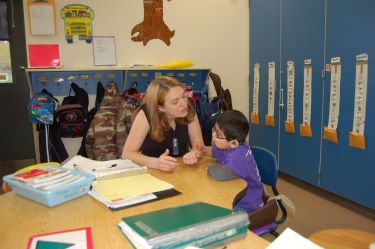Modifications to the Learning Environment
Environments that promote communication and learning for children and youth who are deaf-blind are structured to encourage movement, engagement, and interactions with others.
They consist of physical places and the people, activities, and materials within them. Features include:
- Physical spaces that are accessible, including modifications to auditory and visual conditions that maximize the use of any residual hearing and vision
- People who are respectful and responsive
- Consistency and predictability
- Interesting (including tactually interesting) materials and activities
See also:

The individual who has vision and hearing loss can still build and enjoy a sturdy foundation for learning, and learn to master his powerful uniqueness. The results, however, will depend on an environment that invites and supports learning.(Greeley & Anthony, 1995, p. 185)
Introductory Resources
Learn More
Considerations for Educating Students With CVI: The Learning Environment (PA Training and Technical Assistance Network)
Managing the Environment to Modify Behavior (from OHOA Module "Behavior and Environmental Supports")
Offline Resource
Olson, K., Miles, B., & Riggio, M. (1999). Environments than encourage communication. In B. Miles & M. Riggio (Eds.), Remarkable conversations: A guide to development meaningful communication with children and young adults who are deafblind (pp. 76-93). Perkins School for the Blind.
References
Greeley, J., & Anthony, T. L. (1995). Play interaction with infants and toddlers who are deafblind: Setting the stage. Seminars in Hearing, 16 (2), 185-191.
Olson, K., Miles, B., & Riggio, M. (1999). Environments than encourage communication. In B. Miles & M. Riggio (Eds.), Remarkable conversations: A guide to development meaningful communication with children and young adults who are deafblind (pp. 76-93). Perkins School for the Blind.
Stremel, S., Perreault, S., & Welch, T. R. (1995). Strategies for classroom and community. In K. M. Huebner, J. G. Prickett, T. R. Welch, & E. Joffee, (Eds.), Hand in hand: Essentials of communication and orientation and mobility for your students who are deaf-blind (pp. 411-441). AFB Press.
KEEP EXPLORING